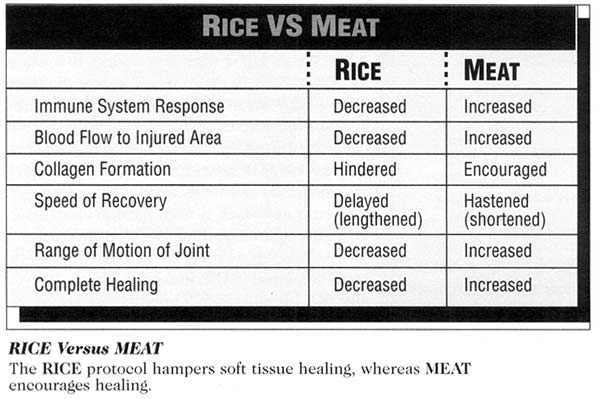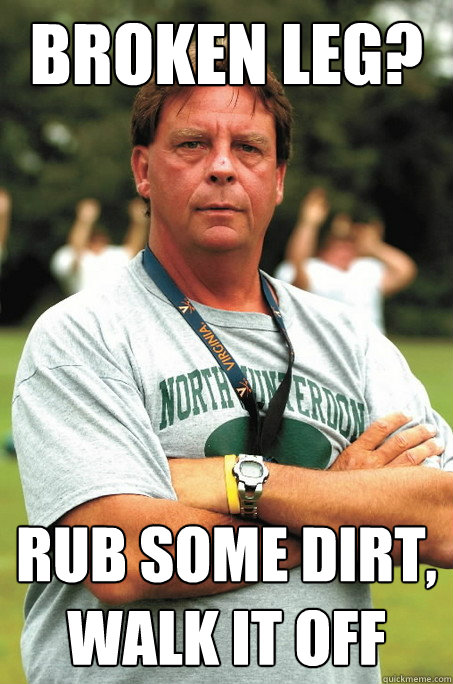Rob3rt
Regular Member
"In my professional opinion, the RICE method is outdated and actually hinders your recovery, hear me out:
We’ve all been there, using muscles we haven’t used in a while or didn’t warm up enough. You swing, stride, throw, or jump and BAM! There comes the pain.
Pulled muscles, AKA strains are actually partial tearing of muscle fibers, the extent of tearing varies, with extreme cases requiring surgical intervention. This is not about those kinds of injuries, this post is for the weekend warriors and athletes that just did a little too much.
Many people are familiar with the “RICE Method”, that is: rest, ice, compress, elevate. While this is all fine and dandy if you have a week before your next competition or can take a week off of training, but most athletes can’t afford that kind of down time, or simply don’t want to wait.
Here’s why the RICE method may slow your recovery:
Rest – Obviously important immediately following an injury to prevent further damage, but after 12-24 hours, rest means disuse, which means potential atrophy and scar deposition. Atrophy is the loss of muscle because the area is not being used, and since it is not being used, your body will deposit scar tissue indiscriminately over the injury site, potentially causing a loss of range of motion or contractile strength even after the injury is fully healed. Know anyone that has had a hip or knee replacement recently? Ask how long they “rested” after surgery...
Ice – Try to swallow this one, ice is useless aside from pain control. There. I said it. Contrary to what your coaches told you, there is no quality evidence that demonstrates ice is effective at healing an injury, in fact, it may delay the process. Think about it, cold therapy constricts blood vessels, decreasing metabolism and circulation, also decreasing the process of inflammation. Fact: YOU CANNOT HEAL WITHOUT INFLAMMATION. Aside from certain ‘runaway inflammatory’ conditions (UC, Crohn’s, RA, etc.), inflammation is a good thing, without it you would not repair. The only time I would use ice to treat an injury is in a competition setting to limit the inflammatory process (mostly swelling) so that someone can continue to compete (think icing a boxer’s face between rounds). Furthermore, cold therapy only penetrates so far, rarely getting to the source. Even more compelling, the doctor that coined the term “RICE” in 1978 (Dr. Gabe Mirkin) has since declared otherwise (see for yourself: (http://www.drmirkin.com/fitness/why-ice-delays-recovery.html).
Compression and elevation have their merits, mostly to control swelling and lymphatic movement. Severely swollen tissues will limit your range of motion. The compression supports the movement of lymph fluid and the elevation uses gravity to help it flow. Lymph fluid is what carries in the repairmen and takes away the damaged materials. This leaves you with “CE” from “RICE”.
How about a better alternative that will help you recover faster??
“MESH” will get you back on the field faster
Following a mild injury/strain, remember this new acronym “M-E-S-H”, here’s how it works:
Movement – As long as no bones are broken and nothing is unstable, start moving the injured area. This can be done by light dynamic stretching, vibration therapy, non-weightbearing movements/oscillations, or something as simple as motion within a tolerable range (flex, extend, rotate, laterally bend). This does not need to be aggressive movement, it should be uncomfortable but not too painful. The goal here is to regain/maintain range of motion, prevent atrophy/scar formation, and stimulate the movement of lymphatic fluid. As you regain motion, you can use more aggressive modalities like foam rolling, muscle sticks, lacrosse balls, and resistance bands.
Elevate – Elevation is used to support the movement of lymphatic fluid and the clearing of damaged tissue from the injured area. Elevate the injured area above the level of the heart (if able to) while at rest so gravity can help fluid move out of the area so it doesn’t become stagnant and accumulate.
Support – Use an ace bandage, elastic taping (KT, Rocktape, etc.) or compression sleeve to support the injured area. This will protect the area from further injury and allow you to get some movement in supported ranges of motion. The added compression from your support will also prevent excessive swelling.
Heat – Yes, heat. The opposite of ice. This is not a necessary step, but will increase blood flow, cell metabolism, and also inflammation (remember, it’s not a bad thing when healing). Heat is best to apply in the days after an injury as a means to loosen stiffness and regain more motion. It should be applied for 10-15 minutes at a time, followed by movement. Do not reapply until the skin temperature has returned to normal.
As you can see, a recurring theme with MESH is movement. Movement is the most important part of healing an injury and the -ESH aims to facilitate the motion. Don’t believe me? Try it for yourself.
If the injury seems to be getting worse over a few days or seems unstable, consult your healthcare provider as it may be more than a mild sprain/strain."
Source: http://www.mooresvillehbs.com/meshinjuryrecovery/
We’ve all been there, using muscles we haven’t used in a while or didn’t warm up enough. You swing, stride, throw, or jump and BAM! There comes the pain.
Pulled muscles, AKA strains are actually partial tearing of muscle fibers, the extent of tearing varies, with extreme cases requiring surgical intervention. This is not about those kinds of injuries, this post is for the weekend warriors and athletes that just did a little too much.
Many people are familiar with the “RICE Method”, that is: rest, ice, compress, elevate. While this is all fine and dandy if you have a week before your next competition or can take a week off of training, but most athletes can’t afford that kind of down time, or simply don’t want to wait.
Here’s why the RICE method may slow your recovery:
Rest – Obviously important immediately following an injury to prevent further damage, but after 12-24 hours, rest means disuse, which means potential atrophy and scar deposition. Atrophy is the loss of muscle because the area is not being used, and since it is not being used, your body will deposit scar tissue indiscriminately over the injury site, potentially causing a loss of range of motion or contractile strength even after the injury is fully healed. Know anyone that has had a hip or knee replacement recently? Ask how long they “rested” after surgery...
Ice – Try to swallow this one, ice is useless aside from pain control. There. I said it. Contrary to what your coaches told you, there is no quality evidence that demonstrates ice is effective at healing an injury, in fact, it may delay the process. Think about it, cold therapy constricts blood vessels, decreasing metabolism and circulation, also decreasing the process of inflammation. Fact: YOU CANNOT HEAL WITHOUT INFLAMMATION. Aside from certain ‘runaway inflammatory’ conditions (UC, Crohn’s, RA, etc.), inflammation is a good thing, without it you would not repair. The only time I would use ice to treat an injury is in a competition setting to limit the inflammatory process (mostly swelling) so that someone can continue to compete (think icing a boxer’s face between rounds). Furthermore, cold therapy only penetrates so far, rarely getting to the source. Even more compelling, the doctor that coined the term “RICE” in 1978 (Dr. Gabe Mirkin) has since declared otherwise (see for yourself: (http://www.drmirkin.com/fitness/why-ice-delays-recovery.html).
Compression and elevation have their merits, mostly to control swelling and lymphatic movement. Severely swollen tissues will limit your range of motion. The compression supports the movement of lymph fluid and the elevation uses gravity to help it flow. Lymph fluid is what carries in the repairmen and takes away the damaged materials. This leaves you with “CE” from “RICE”.
How about a better alternative that will help you recover faster??
“MESH” will get you back on the field faster
Following a mild injury/strain, remember this new acronym “M-E-S-H”, here’s how it works:
Movement – As long as no bones are broken and nothing is unstable, start moving the injured area. This can be done by light dynamic stretching, vibration therapy, non-weightbearing movements/oscillations, or something as simple as motion within a tolerable range (flex, extend, rotate, laterally bend). This does not need to be aggressive movement, it should be uncomfortable but not too painful. The goal here is to regain/maintain range of motion, prevent atrophy/scar formation, and stimulate the movement of lymphatic fluid. As you regain motion, you can use more aggressive modalities like foam rolling, muscle sticks, lacrosse balls, and resistance bands.
Elevate – Elevation is used to support the movement of lymphatic fluid and the clearing of damaged tissue from the injured area. Elevate the injured area above the level of the heart (if able to) while at rest so gravity can help fluid move out of the area so it doesn’t become stagnant and accumulate.
Support – Use an ace bandage, elastic taping (KT, Rocktape, etc.) or compression sleeve to support the injured area. This will protect the area from further injury and allow you to get some movement in supported ranges of motion. The added compression from your support will also prevent excessive swelling.
Heat – Yes, heat. The opposite of ice. This is not a necessary step, but will increase blood flow, cell metabolism, and also inflammation (remember, it’s not a bad thing when healing). Heat is best to apply in the days after an injury as a means to loosen stiffness and regain more motion. It should be applied for 10-15 minutes at a time, followed by movement. Do not reapply until the skin temperature has returned to normal.
As you can see, a recurring theme with MESH is movement. Movement is the most important part of healing an injury and the -ESH aims to facilitate the motion. Don’t believe me? Try it for yourself.
If the injury seems to be getting worse over a few days or seems unstable, consult your healthcare provider as it may be more than a mild sprain/strain."
Source: http://www.mooresvillehbs.com/meshinjuryrecovery/



